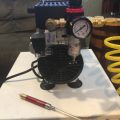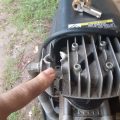In the effort to make more air available for air tools, the question can air compressors be combined comes up? The short answer is yes. As always, there are things to consider when combining air compressors. The information you’ll want to make an informed decision is found on this page.
Table of Contents
- Why consider combining air compressors?
- Combining two compressors
- Power supply and combining air compressors.
- Consider delaying the start of one of the combined air compressors.
- What about the compressor unloader valves, then?
- Check valves may be required
- Already own two air compressors?
Why consider combining air compressors?
Lots of folks, us included, have acquired fairly low cost compressors from a big box store, or on line. Though some of these air compressors advertise that they are suitable for running all kinds of compressed air tools, the reality is that many of them are good for low-air using tools only. When the owner tries to use that compressor to drive an air wrench, a grinder, a drill, maybe a small air blast kit, the available air drops quickly, and the user has to wait for air to regenerate before continuing work.

The tendency is to still continue in using air to drive the tool even as the air supply drops leading to the air tool lacking sufficient air supply to even do the job for which it is being used. Very frustrating!
If that’s the scenario being experienced your options boil down to:
- continue stopping work frequently and waiting for the compressor pump to rebuild the air supply with care taken to ensure the motor doesn’t overheat
- stop trying to use an air tool with an air demand that is greater than that which the air compressor can supply
- rent or purchase a larger air compressor for use with that air tool
- try to combine a couple of smaller air compressors to try to generate sufficient air to run the air tool acceptably
This page details option 4, combining a couple of smaller air compressors to make more compressed air available to drive larger demand air tools, and the issues that the owner will face in trying to do so.
Combining two compressors
In theory, having two compressors with the same cut in and cut out pressure settings, with the air discharge from both connected to one air line that supplies air to the air tool, should provide a longer air supply to the air tool to allow it to work longer without having too frequent air starvations issues.
That is not really the case.
Power supply and combining air compressors.
Assuming there are two air compressors of similar voltage available, an attempt to start both of them at the same time may not be possible.
Compressor electric motors, and pretty much all electric motors, require higher current supply when starting than when they are running. This higher current supply is called “inrush current”. The demand peaks as the compressor pulls amps on startup to get going, and then the current demand lowers after the motor shaft is up to speed.
Depending on the age of the motor, its wear and the load on the shaft, the inrush demand of a motor in amps can be 8 to 100 times as great as when the motor is up to speed.
If a 1 HP motor draws 7 amps running at speed, you can see that the inrush of that motor can quickly reach, and then pass, the ability of a 15 amp breaker to supply power. If the demand exceeds the set point of the breaker it will trip and cut power.
What difference does this make?
If an attempt is to combine a couple of small compressors to start at the same time to generate more air to a circuit, the liklihood of exceeding the capacity of the breaker supplying those outlets is high, and a tripped breaker will result every time.
This is is the biggest reason why combining two compressors is difficult for the home / small workshop user of compressed air; insufficient power supply.
Consider delaying the start of one of the combined air compressors.
To resolve the issue of too-high current draw on start up, it is possible to adjust the starting pressure of the second air compressor to cut in at 5 PSI higher or lower than the other.
The inrush demand of the electric motors can often be measured in fractions of, or seconds of higher current draw, and as long as the second air compressor isn’t attempting a motor start at exactly the same time could resolve the too-high amperage draw issue.
That is, if the pressure switch on the compressor is adjustable so that can be accomplished.
What about the compressor unloader valves, then?
Another issue that will have to be addressed is if both air compressors have unloader valves.
When the compressor is off, the unloader valve will be open, venting any trapped air. While running, the unloader valve is shut, allowing air flow into the tand and not out through the unloader. If both compressors are running at exactly the same time, the unloader valve on both will be closed. That’s find.
But… if either compressor is delayed in starting, for the reasons outlined above. air being generated from the running compressor will simply exit the other compressor unloader valve rather than flowing into the line to the air tool, if both compressors are connected to a combined line. Air will always flow the path of least resistance, and an open valve is less “resisting” than a 50′ air hose.
Check valves may be required
If experimenting with running two compressors at the same time to increase the available air to an air tool, a check valve can be installed in the line from each compressor before the two lines are joined. In this configuration, air can only flow out of the line from a compressor, and cannot back flow back up to a compressors unloader valve if one is open.
Already own two air compressors?
If a person already has two air compressors, then there is some argument for trying to join those two compressors together.
If it is necessary to acquire a new compressor to have two, my advice is to just get one that is large enough in terms of air delivery for the air tools that are to be used, and keep the smaller air compressor for jobs that don’t require a sustained supply of compressed air.
Comments about your experiences in combining two compressors or questions are certainly welcome and will be addressed reasonably quickly upon them being submitted using the comment form below.





![Using an Air Compressor to Clean Your Computer [GUIDE]](https://fix-my-compressor.com/wp-content/uploads/2022/12/cleaning-a-pc-with-an-air-compressor-120x120.jpg)
